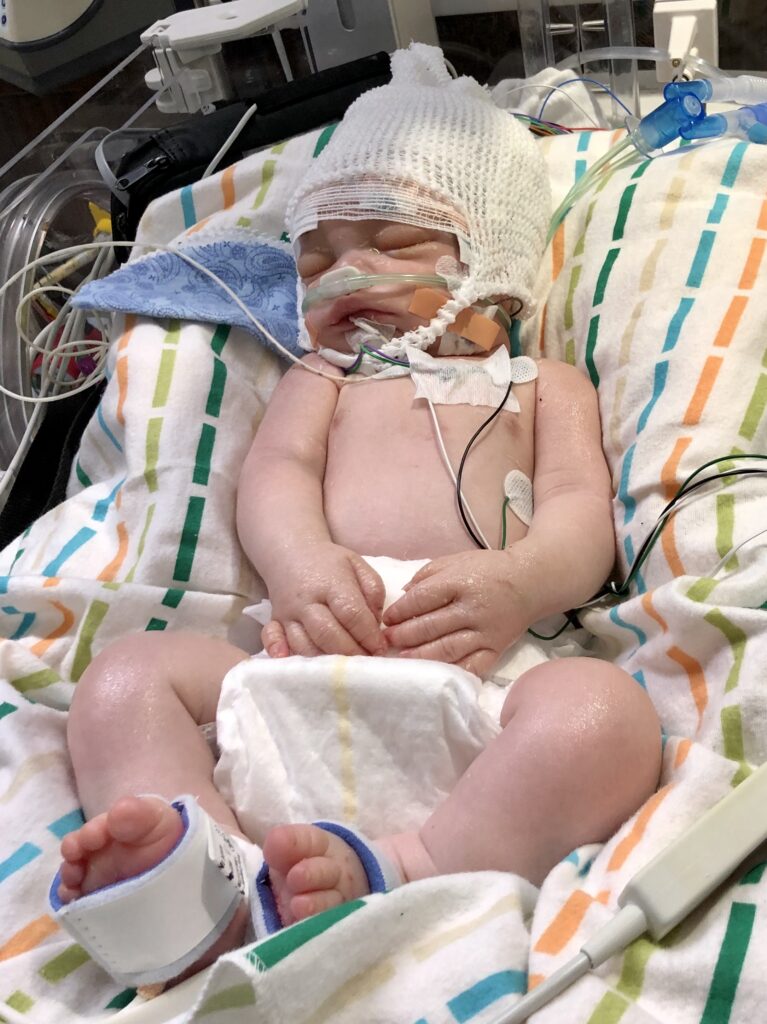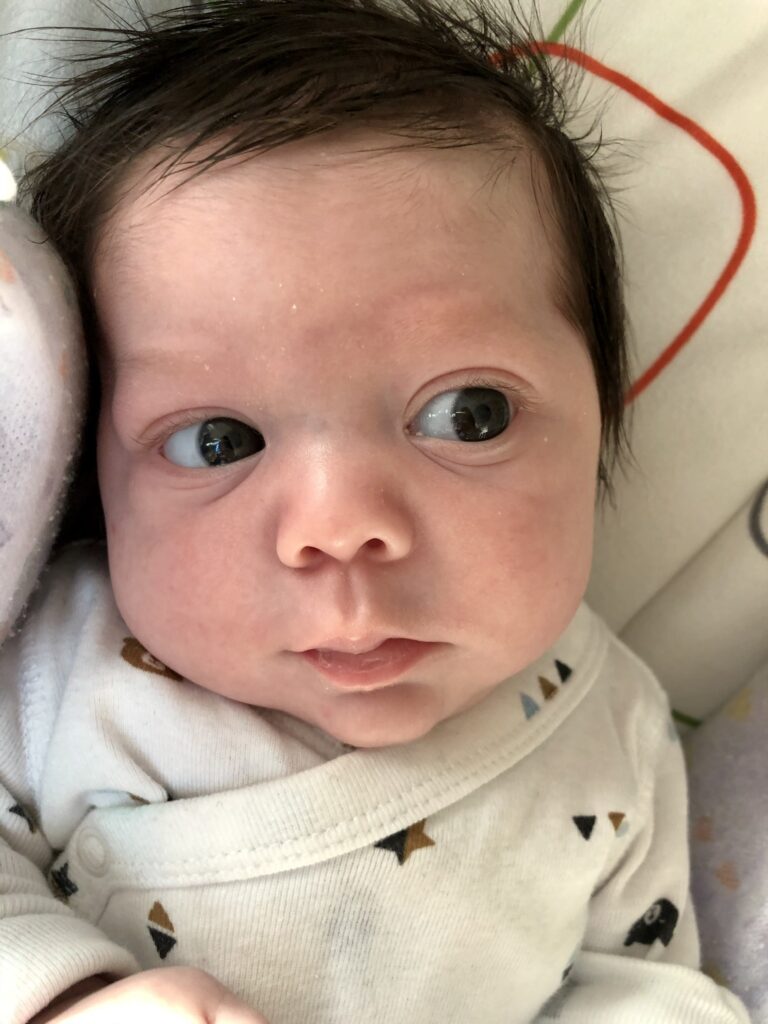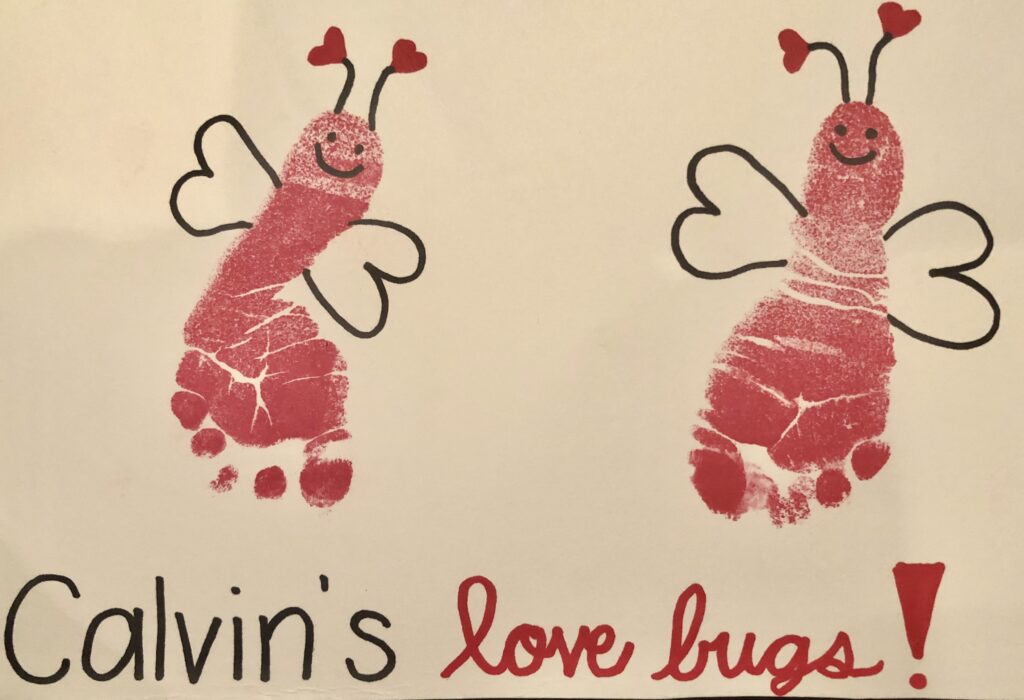
Name: Daniela Romaine
Location: New Jersey, United States
Child’s Birth Year: 2020
Keywords: Loss Parent, Severe Outcome, PTSD & Mental Health
“This was not your fault. This will never be your fault, no matter how many different ways someone tries to tell you it was.”
-Angela Miller, from You Are the Mother of All Mothers
When Daniela became pregnant with her first child, Calvin, in the spring of 2019, she was over the moon ecstatic. As the manager of an infant toddler program at a daycare, Daniela absolutely adored working with little kids. To find out that she would continue to be surrounded by the pure joy and cuteness of a child, even at home, was the greatest feeling. If she and her husband could have shouted from the rooftops that they were going to be parents, they would have.
As a person who actively seeks out knowledge, Daniela googled everything that could potentially go wrong during pregnancy. She learned about heart defects, the various types of trisomy, and all the statistics about miscarriage. Yet, never once in her extensive research did she come across the term HIE. Despite those worries in the back of Daniela’s mind, Calvin was as healthy as could be throughout the pregnancy. He was meeting his kick counts, his growth ultrasounds always looked good, and, overall, there were no real hiccups along the way.
At the forty-week mark, Daniela decided to be induced. She was ready to finally meet her baby boy. Because of her research, Daniela felt prepared and informed about so many things that could go wrong, but she could have never predicted what would come next.
After being induced at a hospital with a level four NICU near where she lived in New Jersey, Daniela labored for a lengthy forty-one hours. When her water broke, the fluid was stained with meconium. Looking back on it, this was an indicator that, perhaps, there was meconium clogged up in Calvin’s lungs, making it hard for him to breathe. But, at the time, none of the doctors or nurses seemed concerned. Daniela wasn’t being monitored very closely, and it wasn’t until the last three to five minutes before Calvin came out that her doctor became concerned. Daniela saw the look on the OB’s face completely change from a state of calm to one of panic. She told the nurse that they needed to go to the NICU immediately.
As the alarms started going off, providers rushed into the room. The only way to describe the influx of bodies was sheer chaos. Calvin came out floppy and lifeless, and he was quickly taken to the back corner of the room to be resuscitated. When Calvin was eventually intubated and stable, he was brought over to Daniela for a few seconds. They touched cheeks with one another, and then Calvin was quickly taken away to the NICU.
Daniela wanted more than just that brief skim of his cheek. She had always dreamed of how magical that first hold would be, cuddling with her son and feeling the warmth of his skin on hers. She had dreamed that these would be the happiest moments of her life, but, instead, she found herself feeling more scared, confused, and helpless than she ever felt before. A blizzard of a million unanswered questions wreaked havoc in her mind: What even happened? Why was he taken to the NICU? How did I go from a perfectly healthy pregnancy with a baby who was meeting his kick counts every day to this nightmare?
Daniela remembers screaming, “Why wasn’t he crying?” repeatedly, but no one could provide any clarity. For the two months of Calvin’s life, Daniela never once heard the sound of her son’s cry.
About an hour and a half after Calvin was born, the neonatologist came into the room with the consent forms for hypothermic cooling. On the form, Daniela saw the term HIE, but no one provided any real explanation as to what it was. All they said was that Calvin had brain damage and that cooling might help. Daniela and her husband didn’t even think twice about signing the forms, willing to try anything to make this all go away.
After the neonatologist left, Daniela began to do her own research online about HIE. It was then that she discovered Hope for HIE on Facebook and finally was able to get some idea of what was going on. As she began to scroll through the forum and read various parent stories, Daniela found comfort in knowing that she was not alone, that there were many others out there who were walking along this same path.
Even in one of the major hospitals in New Jersey, Daniela was forced to find information about HIE on her own. For instance, while providers told Daniela that Calvin had a lot of secretions, she had no idea what to do with that information. It was only after seeking out resources online that she discovered the secretions were because Calvin couldn’t swallow. She constantly felt like she was only given one piece of the puzzle, instead of the entire picture, so Daniela reiterated to providers the importance of explaining things as fully as possible.
During cooling, seeing Calvin look so alone, and not being able to comfort or touch him, was extremely difficult. Daniela was told that Calvin was having subclinical seizures based on the EEG, and it was terrifying knowing that her baby could be in distress that wasn’t even visible to the human eye. After Calvin was rewarmed, he had an MRI, which showed severe global brain damage. When the neurologist essentially told Daniela that Calvin would be in a vegetative state, she immediately tried to brainstorm ways to “fix” the situation, explaining that she had a background in infant development. Unfortunately, the neurologist said that, based on the MRI, he didn’t think Calvin would make it, even with therapy.
Again, questions whirled through Daniela’s mind—how could Calvin suddenly go from this active, constantly kicking baby inside her belly to a dying, nonmobile baby, who couldn’t even breathe on his own? Throughout this journey, that question of why this happened continually haunted her, and, to this day, she has no concrete answers. Like so many cases of HIE, sometimes there is just too much ambiguity and murkiness to ascertain a clear cause.
A couple days later, Daniela and her husband had family come to the hospital to potentially say their final goodbyes. The day they came, Calvin unexpectedly opened his eyes for the first time since being sedated for the cooling. Everyone started seeing a glimmer of hope after days of grim news.
From then on, Calvin seemed to improve, defying the doctors’ initial predictions. He came off the ventilator and could finally breathe on his own, but he still couldn’t suck or swallow. Throughout this transition of preparing for an imminent death to now not being so sure, Daniela turned to the Hope for HIE community for advice on how to best take care of Calvin if he were to survive. Through the other HIE parents, Daniela learned that even newborn babies could do early intervention therapy. After around three and a half weeks, Daniela decided to take Calvin to a specialized children’s therapy hospital.
While Calvin did receive OT, PT, and speech therapy at the new hospital, Daniela felt like being in the comfortable home environment with private therapy would be a better fit. At this point, she also felt confident enough to care for Calvin herself, thanks to all the tips and tricks she learned from the HIE community. Calvin was approved for an early discharge, and Daniela excitedly started filling the calendar with Calvin’s private therapy appointments, feeling ready to show her baby boy his home. But, the day before discharge, just as Daniela thought they were making all these strides forward, Calvin’s health took an unexpected turn for the worse.
Because he was a little older, this time Calvin was admitted to the PICU instead of the NICU. Calvin ended up with pneumonia, and his entire left lung was collapsed. Daniela and her husband were forced to make critical, heartbreaking decisions, such as whether they wanted to continue with surgeries or withdraw life-sustaining treatment. But, through these most difficult days of their lives in the PICU, they received far more support, empathy, and guidance than they had ever received in the NICU. In these PICU days, Daniela often scrolled through Hope for HIE and saw cases of “miracle” babies, who were severely sick at birth, but made a complete turnaround. Daniela kept holding onto the hope that the same thing would happen with Calvin.
But, as each day passed, and his health continued to deteriorate, she had to grapple with the notion that maybe their road wouldn’t look like five therapy appointments a week. Maybe their road would, instead, look like letting Calvin lead the way. If Calvin decided he needed to rest and that this was all just too much, Daniela would still sit by his side until his very last breath.
A children’s hospice team met with Daniela and her husband, and, despite the grim circumstances, they were wonderful. They tailored Calvin’s plan of care by asking Daniela and her husband what their values were and what was most important to them. Knowing how damaged Calvin’s lungs were from inhaling the meconium, their number one priority was spending whatever time they had left with Calvin at home. And, so, Calvin was brought home on hospice after two weeks in the PICU.
Bringing Calvin home while still retaining that faint flicker of hope that maybe he would surprise them—like he did when he’d opened his eyes—was a tough place to be in mentally. On one hand, Daniela was talking to hospice nurses. On the other hand, she was speaking to all the best early intervention therapists she could find. At home, Daniela felt like she had almost become a full-time nurse herself. She was doing chest physical therapy with Calvin constantly, managing countless machines, such as the cough-assist machine, and giving him around-the-clock medications.
Then, after three days of being at home, Calvin’s health worsened even more. When the hospice nurses came to see him, they said that his lungs sounded “junky.” It was an utterly confusing time, not knowing whether Calvin would die, potentially within a day, or hold on for a few weeks longer.
But, at that point—after weeks of procedures, monitoring, and constant pain—Daniela and her husband decided to just let Calvin rest and be a baby. No more nurses came to the home, and, finally, it was just the three of them, together in the present moment.
Those next few days, Daniela and her husband briefly felt what it was like to be “normal” parents, simply spending as much time with Calvin as possible. Daniela held and cuddled with Calvin, making up for all that lost time when she couldn’t touch him. She gave him little baby massages and combed his hair, which he absolutely adored. In the evenings, the three of them sat together on the couch, watching TV.
And, on his last night, after giving Calvin a bath, Daniela and her husband laid him down between the two of them. As he was nested in this circle of warmth, snuggling with his mom, dad, and two cats, he passed away. It was beyond heartbreaking, but it was also the most peaceful way he could have gone. This whole journey had been so tough on Calvin, from the G-tube surgery to the seizures to incessant blood draws. So, Daniela was happy that, in the end, she and her husband were able to give Calvin those last few days of respite, comfort, and undying love.
On March 11, 2020, just as the pandemic hit, Daniela and her husband commenced a new chapter in their lives: life as loss parents, without their beautiful, baby boy. After Calvin passed away, Daniela thought there was no possible way she could ever find hope again. And yet, Daniela found a new type of hope in the amazing friendships she has forged with fellow HIE loss mothers. Around a week after Calvin died, Daniela posted her story in the Loss Support for Parents group, hoping to connect with other mothers who had lost their first baby. She shared how she couldn’t deal with the deafening silence that had settled over her household. She wrote about how expecting your home to be filled with laughter, crying, and babbling, and instead walking past an empty nursery, was suffocating. Because the world was in the midst of a global pandemic, Daniela couldn’t even see her friends and family in person. She felt like she was drowning, deep in a sea of grief, with no one to help pull her out. After her post, two loss moms immediately reached out to Daniela, and one of them connected her to two other moms. Before Daniela knew it, she found herself rising slowly toward the surface, a little closer to finally being able to gasp for air once more.
Daniela joined a group chat with these four other mothers, who understood what she was going through, and whose babies had all passed away within months of Calvin. Together, they had weekly Zoom calls, talking and ranting and supporting one another for hours on end. In the beginning, their calls were filled with tears the entire time, mostly centered around the immense grief they all felt in the wake of devastating losses. But, over time, they began to slowly heal alongside one another and got to know each other in different ways.
Over a year later, their calls are still filled with tears, but they are also filled with jokes, laughter, and conversations about hobbies, such as cooking. Daniela has attended general infant loss groups in her area that have been helpful. But, for her, this close-knit community of five has been supportive unlike anything else. Because the HIE journey is so unique, Daniela was truly able to bond with them over the shared experience of a healthy pregnancy unexpectedly transforming into the worst nightmare imaginable. The five of them text all the time, sending each other gifts on the birthdays of their babies, and sending photos of things that remind them of one another’s babies. It’s crazy to think how, even though Daniela has never physically met any of these fellow loss moms, they have become like family to her. For Daniela, her hope is not that Calvin will grow up and be healthy—that is no longer a possibility. For her, hope means realizing she can survive in this new chapter in her life. Hope means finding strength and lifelong friendship within the loss community.
Daniela cannot emphasize enough the importance of finding that community, whether it is through local support groups or people you have met online. Being a parent to a child with HIE is such an incredibly isolating experience, so having those people, who get it, makes a world of difference.
In addition, Daniela recommends therapy as a way to work through all the trauma. For Daniela, Eye Movement Desensitization and Reprocessing (EMDR) therapy has been the biggest game-changer in terms of reprocessing all the trauma of the birth, NICU stay, and loss of Calvin. Daniela had triggers that interfered with her daily life, and she realized that trying to avoid them was impossible. For the longest time, the smell of Purell would completely break her heart, as it would take her right back to the times where she sanitized her hands before seeing Calvin in the NICU. Suddenly, all those same alarm bells that went off when Calvin couldn’t breathe rang loudly in her mind. The pandemic was a time when everyone seemed to be painting their hands in Purell, so Daniela recognized that not addressing her PTSD meant she wouldn’t be able to go out in public without entirely breaking down. Through EMDR therapy, Daniela was able to unpackage all of the traumatizing events she had experienced and grapple with what actually happened. Because of all her hard work and vulnerability, Daniela is on a healing path—and she hopes that other HIE parents can also find a similar sense of peace.
On top of the trauma, Daniela felt so much guilt for the pain that Calvin had to endure, analyzing potential ways she had failed as a mother. Questions like “What could I have done differently during my pregnancy to have protected Calvin’s brain?” kept her up at night. What helped her acknowledge that her circumstances were out of her control was reading a book called You Are the Mother of All Mothers by Angela Miller. When she read the messages about how she, Calvin’s mother, didn’t fail—not even a little—she felt immensely validated and free. Free from the burden of waking up thinking she could have prevented this loss had she tried a little bit harder. Free from the burden of going to sleep thinking she should have loved and comforted Calvin harder than she had.
Daniela is proud of how far she has come in terms of learning to love herself again, instead of tearing herself down. She is proud that, because of this journey, she has learned how to advocate for herself and her loved ones. But, most of all, she is proud of keeping Calvin’s memory alive through sharing her story. Even though Calvin is no longer here, he is everywhere, irrevocably present in Daniela and her husband’s lives. At least once a day, Daniela or her husband will start a sentence along the lines of “I bet Calvin would have liked that” or “Calvin definitely would not have liked that.” She is proud that, because of all the work she did in therapy to cope with her trauma, she is now able to openly talk about Calvin and let the happy moments resonate.
None of her family nor her friends really had the chance to meet Calvin due to the pandemic, so Daniela tells them bits and pieces about him in conversations. She shares that, even though Calvin had brain damage, he had the funniest, sweetest personality ever. He had the stinkiest little feet and the most beautiful head of hair. He was a true mama’s boy, and he would crack goofy smiles when Daniela kissed him.
And, even though he was nonverbal and couldn’t cry, he made chattery noises, reminiscent of dolphin sounds, to express discomfort. Now, anytime Daniela or her husband sees dolphins, they think of their resilient, wonderful, forever-present little boy. Even if people are uncomfortable talking about a child who has died, Daniela will continue to share Calvin with the world. For he is still very much part of their family, and that is never going to change.
Calvin was here, and he was real. In many ways, he is still here, and he certainly still is real.



Connect with families, read inspiring stories, and get helpful resources delivered right to your inbox.